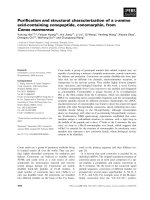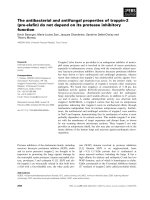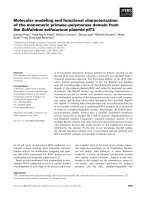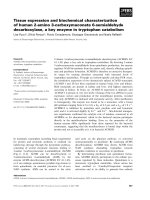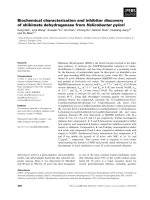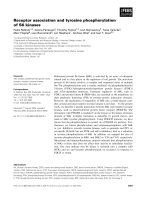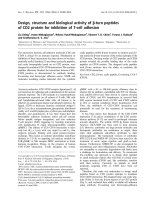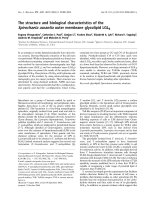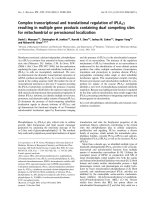Báo cáo khoa học: "Correlating Human and Automatic Evaluation of a German Surface Realiser" doc
Bạn đang xem bản rút gọn của tài liệu. Xem và tải ngay bản đầy đủ của tài liệu tại đây (89.63 KB, 4 trang )
Proceedings of the ACL-IJCNLP 2009 Conference Short Papers, pages 97–100,
Suntec, Singapore, 4 August 2009.
c
2009 ACL and AFNLP
Correlating Human and Automatic Evaluation of a German Surface
Realiser
Aoife Cahill
Institut f
¨
ur Maschinelle Sprachverarbeitung (IMS)
University of Stuttgart
70174 Stuttgart, Germany
Abstract
We examine correlations between native
speaker judgements on automatically gen-
erated German text against automatic eval-
uation metrics. We look at a number of
metrics from the MT and Summarisation
communities and find that for a relative
ranking task, most automatic metrics per-
form equally well and have fairly strong
correlations to the human judgements.
In contrast, on a naturalness judgement
task, the General Text Matcher (GTM) tool
correlates best overall, although in gen-
eral, correlation between the human judge-
ments and the automatic metrics was quite
weak.
1 Introduction
During the development of a surface realisation
system, it is important to be able to quickly and au-
tomatically evaluate its performance. The evalua-
tion of a string realisation system usually involves
string comparisons between the output of the sys-
tem and some gold standard set of strings. Typi-
cally automatic metrics from the fields of Machine
Translation (e.g. BLEU) or Summarisation (e.g.
ROUGE) are used, but it is not clear how success-
ful or even appropriate these are. Belz and Reiter
(2006) and Reiter and Belz (2009) describe com-
parison experiments between the automatic eval-
uation of system output and human (expert and
non-expert) evaluation of the same data (English
weather forecasts). Their findings show that the
NIST metric correlates best with the human judge-
ments, and all automatic metrics favour systems
that generate based on frequency. They conclude
that automatic evaluations should be accompanied
by human evaluations where possible. Stent et al.
(2005) investigate a number of automatic evalua-
tion methods for generation in terms of adequacy
and fluency on automatically generated English
paraphrases. They find that the automatic metrics
are reasonably good at measuring adequacy, but
not good measures of fluency, i.e. syntactic cor-
rectness.
In this paper, we carry out experiments to corre-
late automatic evaluation of the output of a surface
realisation ranking system for German against hu-
man judgements. We particularly look at correla-
tions at the individual sentence level.
2 Human Evaluation Experiments
The data used in our experiments is the output of
the Cahill et al. (2007) German realisation rank-
ing system. That system is couched within the
Lexical Functional Grammar (LFG) grammatical
framework. LFG has two levels of representa-
tion, C(onstituent)-Structure which is a context-
free tree representation and F(unctional)-Structure
which is a recursive attribute-value matrix captur-
ing basic predicate-argument-adjunct relations.
Cahill et al. (2007) use a large-scale hand-
crafted grammar (Rohrer and Forst, 2006) to gen-
erate a number of (almost always) grammatical
sentences given an input F-Structure. They show
that a linguistically-inspired log-linear ranking
model outperforms a simple baseline tri-gram lan-
guage model trained on the Huge German Corpus
(HGC), a corpus of 200 million words of newspa-
per and other text.
Cahill and Forst (2009) describe a number of
experiments where they collect judgements from
native speakers about the three systems com-
pared in Cahill et al. (2007): (i) the original
corpus string, (ii) the string chosen by the lan-
guage model, and (iii) the string chosen by the
linguistically-inspired log-linear model.
1
We only
take the data from 2 of those experiments since
the remaining experiments would not provide any
1
In all cases, the three strings were different.
97
informative correlations. In the first experiment
that we consider (A), subjects are asked to rank
on a scale from 1–3 (1 being the best, 3 being
the worst) the output of the three systems (joint
rankings were not permitted). In the second ex-
periment (B), subjects were asked to rank on a
scale from 1–5 (1 being the worst, 5 being the
best) how natural sounding the string chosen by
the log-linear model was. The goal of experiment
B was to determine whether the log-linear model
was choosing good or bad alternatives to the orig-
inal string. Judgements on the data were collected
from 24 native German speakers. There were 44
items in Experiment A with an average sentence
length of 14.4, and there were 52 items in Exper-
iment B with an average sentence length of 12.1.
Each item was judged by each native speaker at
least once.
3 Correlation with Automatic Metrics
We examine the correlation between the human
judgements and a number of automatic metrics:
BLEU (Papineni et al., 2001) calculates the number of n-
grams a solution shares with a reference, adjusted by a
brevity penalty. Usually the geometric mean for scores
up to 4-gram are reported.
ROUGE (Lin, 2004) is an evaluation metric designed to eval-
uate automatically generated summaries. It comprises
a number of string comparison methods including n-
gram matching and skip-ngrams. We use the default
ROUGE-L longest common subsequence f-score mea-
sure.
2
GTM General Text Matching (Melamed et al., 2003) calcu-
lates word overlap between a reference and a solution,
without double counting duplicate words. It places less
importance on word order than BLEU.
SED Levenshtein (String Edit) distance
WER Word Error Rate
TER Translation Error Rate (Snover et al., 2006) computes
the number of insertions, deletions, substitutions and
shifts needed to match a solution to a reference.
Most of these metrics come from the Machine
Translation field, where the task is arguably sig-
nificantly different. In the evaluation of a surface
realisation system (as opposed to a complete gen-
eration system), typically the choice of vocabulary
is limited and often the task is closer to word re-
ordering. Many of the MT metrics have methods
2
Preliminary experiments with the skip n-grams per-
formed worse than the default parameters.
Experiment A Experiment B
GOLD LM LL LL
human A (rank 1–3) 1.4 2.55 2.05
human B (scale 1–5) 3.92
BLEU 1.0 0.67 0.72 0.79
ROUGE-L 1.0 0.85 0.78 0.85
GTM 1.0 0.55 0.60 0.74
SED 1.0 0.54 0.61 0.71
WER 0.0 48.04 39.88 28.83
TER 0.0 0.16 0.14 0.11
DEP 100 82.60 87.50 93.11
WDEP 1.0 0.70 0.82 0.90
Table 1: Average scores of each metric for Exper-
iment A data
Sentence Corpus
corr p-value corr p-value
BLEU -0.615 <0.001 -1 0.3333
ROUGE-L -0.644 <0.001 -0.5 1
GTM -0.643 <0.001 -1 0.3333
SED -0.628 <0.001 -1 0.3333
WER 0.623 <0.001 1 0.3333
TER 0.608 <0.001 1 0.3333
Table 2: Correlation between human judgements
for experiment A (rank 1–3) and automatic metrics
for attempting to account for different but equiva-
lent translations of a given source word, typically
by integrating a lexical resource such as WordNet.
Also, these metrics were mostly designed to eval-
uate English output, so it is not clear that they will
be equally appropriate for other languages, espe-
cially freer word order ones, such as German.
The scores given by each metric for the data
used in both experiments are presented in Table 1.
For the Experiment A data, we use the Spearman
rank correlation coefficient to measure the corre-
lation between the human judgements and the au-
tomatic scorers. The results are presented in Table
2 for both the sentence and the corpus level corre-
lations, we also present p-values for statistical sig-
nificance. Since we only have judgements on three
systems, the corpus correlation is not that informa-
tive. Interestingly, the ROUGE-L metric is the only
one that does not rank the output of the three sys-
tems in the same order as the judges. It ranks the
strings chosen by the language model higher than
the strings chosen by the log-linear model. How-
ever, at the level of the individual sentence, the
ROUGE-L metric correlates best with the human
judgements. The GTM metric correlates at about
the same level, but in general there seems to be
little difference between the metrics.
For the Experiment B data we use the Pearson
correlation coefficient to measure the correlation
between the human judgements and the automatic
98
Sentence
Correlation P-Value
BLEU 0.095 0.5048
ROUGE-L 0.207 0.1417
GTM 0.424 0.0017
SED 0.168 0.2344
WER -0.188 0.1817
TER -0.024 0.8646
Table 3: Correlation between human judgements
for experiment B (naturalness scale 1–5) and au-
tomatic metrics
metrics. The results are given in Table 3. Here
we only look at the correlation at the individual
sentence level, since we are looking at data from
only one system. For this data, the GTM met-
ric clearly correlates most closely with the human
judgements, and it is the only metric that has a sta-
tistically significant correlation. BLEU and TER
correlate particularly poorly, with correlation co-
efficients very close to zero.
3.1 Syntactic Metrics
Recently, there has been a move towards more
syntactic, rather than purely string based, evalu-
ation of MT output and summarisation (Hovy et
al., 2005; Owczarzak et al., 2008). The idea is to
go beyond simple string comparisons and evaluate
at a deeper linguistic level. Since most of the work
in this direction has only been carried out for En-
glish so far, we apply the idea rather than a specific
tool to the data. We parse the data from both ex-
periments with a German dependency parser (Hall
and Nivre, 2008) trained on the TIGER Treebank
(with sentences 8000-10000 heldout for testing).
This parser achieves 91.23% labelled accuracy on
the 2000-sentence test set.
To calculate the correlation between the human
judgements and the dependency parser, we parse
the original strings as well as the strings chosen
by the log-linear and language models. The stan-
dard evaluation procedure relies on both strings
being identical to calculate (un-)labelled depen-
dency accuracy, and so we map the dependen-
cies produced by the parser into sets of triples
as used in the evaluation software of Crouch et
al. (2002) where each dependency is represented
as deprel(head,word) and each word is in-
dexed with its position in the original string.
3
We
compare the parses for both experiments against
3
This is a 1-1 mapping, and the indexing ensures that du-
plicate words in a sentence are not confused.
Experiment A Experiment B
corr p-value corr p-value
Dependencies -0.640 <0.001 0.186 0.1860
Unweighted Deps -0.657 <0.001 0.290 0.03686
Table 4: Correlation between dependency-based
evaluation and human judgements
the parses of the original strings. We calculate
both a weighted and unweighted dependency f-
score, as given in Table 1. The unweighted f-score
is calculated by taking the average of the scores
for each dependency type, while the weighted f-
score weighs each average score by its frequency
in the test corpus. We calculate the Spearman
and Pearson correlation coefficients as before; the
results are given in Table 4. The results show
that the unweighted dependencies correlate more
closely (and statistically significantly) with the hu-
man judgements than the weighted ones. This sug-
gests that the frequency of a dependency type does
not matter as much as its overall correctness.
4 Discussion
The large discrepancy between the absolute corre-
lation coefficients for Experiment A and B can be
explained by the fact that they are different tasks.
Experiment A ranks 3 strings relative to one an-
other, while Experiment B measures the natural-
ness of the string. We would expect automatic
metrics to be better at the first task than the sec-
ond, as it is easier to rank systems relative to each
other than to give a system an absolute score.
Disappointingly, the correlation between the de-
pendency parsing metric and the human judge-
ments was no higher than the simple GTM string-
based metric (although it did outperform all other
automatic metrics). This does not correspond to
related work on English Summarisation evalua-
tion (Owczarzak, 2009) which shows that a met-
ric based on an automatically induced LFG parser
for English achieves comparable or higher correla-
tion with human judgements than ROUGE and Ba-
sic Elements (BE).
4
Parsers of German typically
do not achieve as high performance as their En-
glish counterparts, and further experiments includ-
ing alternative parsers are needed to see if we can
improve performance of this metric.
The data used in our experiments was almost
always grammatically correct. Therefore the task
4
The GTM metric was not compared in that paper
99
of an evaluation system is to score more natural
sounding strings higher than marked or unnatural
ones. In this respect, our findings mirror those of
Stent et al. (2005) for English data, that the au-
tomatic metrics do not correlate well with human
judges on syntactic correctness.
5 Conclusions
We presented data that examined the correla-
tion between native speaker judgements and au-
tomatic evaluation metrics on automatically gen-
erated German text. We found that for our first
experiment, all metrics were correlated to roughly
the same degree (with ROUGE-L achieving the
highest correlation at an individual sentence level
and the GTM tool not far behind). At a corpus
level all except ROUGE were in agreement with
the human judgements. In the second experiment,
the General Text Matcher Tool had the strongest
correlation. We carried out an experiment to test
whether a more sophisticated syntax-based evalua-
tion metric performed better than the more simple
string-based ones. We found that while the un-
weighted dependency evaluation metric correlated
with the human judgements more strongly than al-
most all metrics, it did not outperform the GTM
tool. The correlation between the human judge-
ments and the automatic evaluation metrics was
much higher for the relative ranking task than for
the naturalness task.
Acknowledgments
This work was funded by the Collaborative Re-
search Centre (SFB 732) at the University of
Stuttgart. We would like to thank Martin Forst,
Alex Fraser and the anonymous reviewers for their
helpful feedback. Furthermore, we would like
to thank Johan Hall, Joakim Nivre and Yannick
Versely for their help in retraining the MALT de-
pendency parser with our data set.
References
Anja Belz and Ehud Reiter. 2006. Comparing auto-
matic and human evaluation of NLG systems. In
Proceedings of EACL 2006, pages 313–320, Trento,
Italy.
Aoife Cahill and Martin Forst. 2009. Human Eval-
uation of a German Surface Realisation Ranker. In
Proceedings of EACL 2009, pages 112–120, Athens,
Greece, March.
Aoife Cahill, Martin Forst, and Christian Rohrer. 2007.
Stochastic Realisation Ranking for a Free Word Or-
der Language. In Proceedings of ENLG-07, pages
17–24, Saarbr
¨
ucken, Germany, June.
Richard Crouch, Ron Kaplan, Tracy Holloway King,
and Stefan Riezler. 2002. A comparison of evalu-
ation metrics for a broad coverage parser. In Pro-
ceedings of the LREC Workshop: Beyond PARSE-
VAL, pages 67–74, Las Palmas, Spain.
Johan Hall and Joakim Nivre. 2008. A dependency-
driven parser for German dependency and con-
stituency representations. In Proceedings of
the Workshop on Parsing German, pages 47–54,
Columbus, Ohio, June.
Eduard Hovy, Chin yew Lin, and Liang Zhou. 2005.
Evaluating duc 2005 using basic elements. In Pro-
ceedings of DUC-2005.
Chin-Yew Lin. 2004. Rouge: A package for auto-
matic evaluation of summaries. In Stan Szpakowicz
Marie-Francine Moens, editor, Text Summarization
Branches Out: Proceedings of the ACL-04 Work-
shop, pages 74–81, Barcelona, Spain, July.
I. Dan Melamed, Ryan Green, and Joseph P. Turian.
2003. Precision and recall of machine translation.
In Proceedings of NAACL-03, pages 61–63, NJ,
USA.
Karolina Owczarzak, Josef van Genabith, and Andy
Way. 2008. Evaluating machine translation with
LFG dependencies. Machine Translation, 21:95–
119.
Karolina Owczarzak. 2009. DEPEVAL(summ):
Dependency-based Evaluation for Automatic Sum-
maries. In Proceedings of ACL-IJCNLP 2009, Sin-
gapore.
Kishore Papineni, Salim Roukos, Todd Ward, and Wei-
Jing Zhu. 2001. Bleu: a method for automatic
evaluation of machine translation. In Proceedings
of ACL-02, pages 311–318, NJ, USA.
Ehud Reiter and Anja Belz. 2009. An Investigation
into the Validity of Some Metrics for Automatically
Evaluating Natural Language Generation Systems.
Computational Linguistics, 35.
Christian Rohrer and Martin Forst. 2006. Improving
Coverage and Parsing Quality of a Large-Scale LFG
for German. In Proceedings of LREC 2006, Genoa,
Italy.
Matthew Snover, Bonnie Dorr, Richard Schwartz, Lin-
nea Micciulla, and Ralph Weischedel. 2006. A
study of translation error rate with targeted human
annotation. In Proceedings of AMTA 2006, pages
223–231.
Amanda Stent, Matthew Marge, and Mohit Singhai.
2005. Evaluating evaluation methods for generation
in the presense of variation. In Proceedings of CI-
CLING, pages 341–351.
100

